Art Bites: How ‘Avant Garde’ Became an Art Term
The term “avant-garde” describes movements, artists, and artworks that challenge the status quo. Often seen as merely provocative and controversial in their day, they retrospectively come to be understood as revolutionary—cornerstones in the development of art as we know it. The term is borrowed from French, where it originally referred to the vanguard of an army, a reconnaissance party that scouts what lies ahead. How, then, did a military metaphor become applicable to art?
The term’s initial use in the arts is credited to the 19th-century theorist Henri de Saint-Simon, a forefather of Utopian Socialism. He wrote, “We artists will serve you as an avant-garde, the power of the arts is most immediate: when we want to spread new ideas we inscribe them on marble or canvas. What a magnificent destiny for the arts is that of exercising a positive power over society.”
In his view, scientists, industrialists, and artists were at the cutting edge, ushering in new eras of thought and culture.
For an artist, to be avant-garde, then, is to embody both aesthetic and social progressiveness. This can certainly be said of Gustave Courbet, who led the subversive movement of Realism after the French Revolution of 1848. He believed that radical artists had to exist at odds with the ruling class, both ideologically and through their artistic practice. Realism rejected the notion of exotic, vaulted subject matter in art, seeking instead to depict quotidian scenes and ordinary people with veracity. In Courbet’s world, there was no room for romantic ideals and emotions. Rather, the focus shifted to the naked truth, including the ignobility of life that came after the Industrial Revolution.

Other avant-garde artistic movements equally pushed social agendas, such as the antimilitarist and antinationalist manifestos of André Breton’s Surrealism after World War I, expressed through art that captured the subconscious and the dreamlike. Italian poet Filippo Tommaso Marinetti’s Futurism sought to capture the energy and dynamism of the new world through art, pledging to “free Italy from her innumerable museums which cover her like countless cemeteries.” His manifesto celebrated the beauty of speed, proclaiming that a race car was more beautiful than any ancient statue collecting dust.
Though such structured movements are less common in the contemporary art world, “avant-garde” continues to apply to art or literature that challenges the zeitgeist through form, concept or both. It has been used to describe works of theater such as American playwright Jeremy O. Harris’ “Slave Play,” which explores race, trauma and sex through interracial relationships where couples roleplay white-black, master-slave relationships to better understand how their own racial identities affect their sexual dynamics. “Testo Junkie,” described as “auto-theory” by Spanish author Paul B. Preciado, defies genre by utilizing narrative, dense theory, and historical research to study the impact of synthetic hormones and the pornography industry on gender.
Subscribe to our mailing list
We will process the personal data you have supplied in accordance with our privacy policy.





